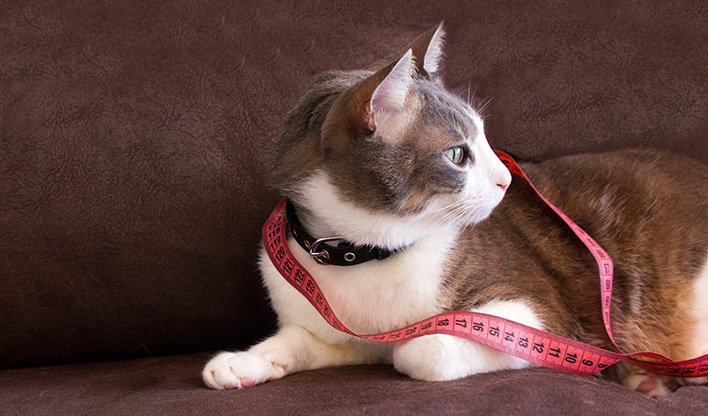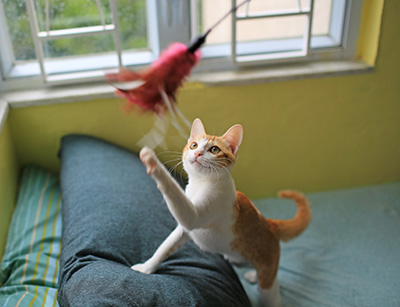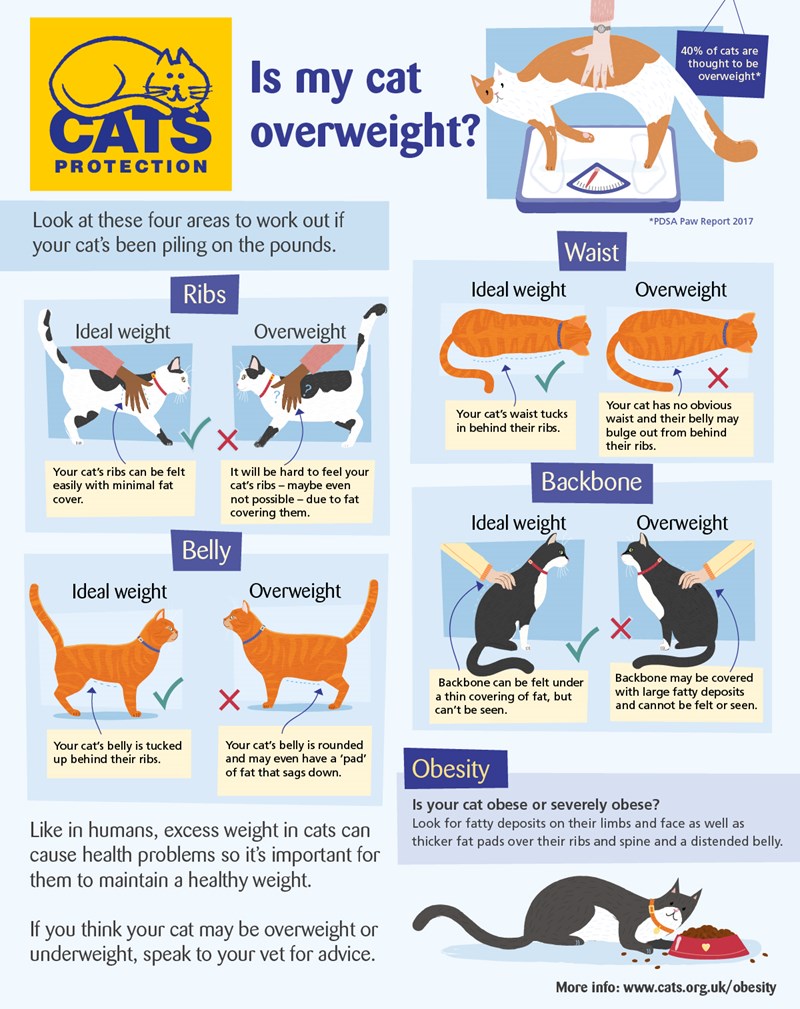Find out how to monitor and maintain a healthy weight for your cat.
Zumba classes and gym memberships aren't an option for cats (as far as we know!). So if your feline friend is filling out, they will need your help to get back into shape.

Helping Your Cat Get Into Shape
We humans often make lifestyle changes to keep our health and weight in check. This can involve gym memberships, swimming or cycling, counting calories, or even pounding it out on interactive fitness games. But what happens when our feline friends start filling out? According to a study by the PDSA, as many as 40% of cats in the UK are classed as overweight! In this blog, we’re going to give you some ideas to help your podgy puss get back into shape.
You might think that a little extra weight is no big deal, but sadly overweight cats are more prone to developing health conditions such as diabetes, urinary infections or arthritis. It can also shorten their lifespan, so it’s definitely not something to ignore
How do you know if your cat is overweight?
 Most of us probably don’t know what a healthy weight is for our cat, and with fur helping to disguise any flabby bits, it can be hard to tell by just looking. Add to that the varying ideal weights depending on age, breed and size, and it can be quite difficult to judge.
Most of us probably don’t know what a healthy weight is for our cat, and with fur helping to disguise any flabby bits, it can be hard to tell by just looking. Add to that the varying ideal weights depending on age, breed and size, and it can be quite difficult to judge.
The best way to find out if your cat needs to slim down a bit is to take them to the vet, who can weigh them and advise on their ideal weight. You can also follow the steps below:
Feel: You should be able to feel your cat’s ribs and backbone easily. Underneath, their stomach should go up and not bulge out.
Look: Stand over your cat and look at them from above, their waist should tuck in behind their ribs.
Observe: Keep an eye on their behaviour; are they struggling to jump up onto the sofa? Do they seem out of breath or worn out when running or playing?
Weigh: Even if you don’t know your cat’s ideal weight, you should still keep an eye on it in case there are any fluctuations you might need to report to your vet.
(Tip: If your cat won’t sit still on the scales, weigh yourself standing on them, both with and without the cat in your arms, and then calculate the difference).
It can help to see some visuals when it comes to checking the above, so take a look at this helpful chart below, produced by Cats Protection (used with kind permission).
What causes cats to put on extra weight?
As with humans, cats put on weight when they eat too much and do not get enough exercise. Weight gain in cats can also be down to a medical condition; another reason to get them checked out by a vet so this can be ruled out.
We all know how easy it is to spoil our cats with treats and little tastes of our own food, but the kindest thing you can do for your overweight cat is help them to lose weight. There are two things you can do to help; control their food intake and increase their exercise.
Controlling your cat’s diet
Just like all animals, cats need a balanced diet with the right amount of nutrients to stay fit and healthy. Cats need more protein than most other mammals, so they do require meat in their diet. Standard cat food is usually classed as either complete or complementary; complete food contains all the necessary nutrients in the right balance whilst complementary foods need to be combined with other nutrition sources.
Whether you choose to feed your cat wet or dry food, or a mixture of both, make sure you read the packaging to find out the correct amount to feed to your cat. A good weight loss strategy is to gradually move to food with a higher protein content, rather than simply cutting down on portions of your cat's regular food. This will ensure they maintain muscle mass and healthy joints, and prevent them feeling hungry.
It's a good idea to discuss a diet plan with your vet beforehand. This could simply mean switching brands, or even changing to a specialist cat food to help control your cat’s weight.
Feeding your cat from your own plate is never a good idea. This will soon become a habit, which can lead to them gaining weight. It can also put them off eating their own food, which contains a good balance of nutrition and calories to keep them healthy.
If you have more than one cat in the house it can be hard to control what each cat eats. Try feeding them in separate rooms so that they do not steal each other’s food. Alternatively, you can buy microchip controlled food bowls that will only allow the cat whose chip is recognised to access the food.
Water water everywhere...
Remember, no matter what food you choose to feed your cat they do need fresh water which should be changed daily. Cats prefer their water bowls to be situated somewhere quiet, and away from their food. By placing several water bowls around the house, your cat will drink more, which helps their digestion and can assist in weight loss.
Establish a mealtimes routine
Does your cat pester you for food every time you go into the kitchen? Some cats it seems, can hear a kitchen cupboard opening no matter how far away they are! Establishing regular mealtimes will help you regulate their food intake, and reduce between-meals snacking.
One tried and trusted way to do this is by choosing a specific sound to “call” your cats when it’s a mealtime, and ONLY serving food at those times. This could be rattling bowls together, banging a spoon on a saucepan or even ringing a dinner bell! A cat will soon learn that this sound, and only this sound means food. In the early days of learning this new system, don’t give in when they follow you into the kitchen expecting something “extra”; instead reward them with a fuss and a couple of minutes playtime.
Cats like routine, so it shouldn’t take more than a week to establish this new method, and you won’t be hassled ten times a day for treats!
How to encourage your cat to exercise
 There might not be slimming clubs or Zumba classes for cats (yet… note to self - possible new business idea!), but there are lots of things you can do to help your feline get fit. Indoor cats especially can be prone to gaining excess weight due to their smaller territory and lack of hunting. But that doesn’t mean they can’t get their heart rate up, so here are some ideas to help your cat get moving. Cats are born hunters so some of these tips will bring out their natural predatory instincts.
There might not be slimming clubs or Zumba classes for cats (yet… note to self - possible new business idea!), but there are lots of things you can do to help your feline get fit. Indoor cats especially can be prone to gaining excess weight due to their smaller territory and lack of hunting. But that doesn’t mean they can’t get their heart rate up, so here are some ideas to help your cat get moving. Cats are born hunters so some of these tips will bring out their natural predatory instincts.
- Interactive Play: Playing with your cat is one of the best ways you can get them moving more. Whether it’s a wand-style toy, a laser pointer, or a catnip mouse, toys are a fun way to encourage your cats to exercise while spending time with them. Aim to get them playing for half an hour a day, which could be in three ten minute sessions. Check out some great cats toys in our webshop.
- Independent Play: To further increase your cat’s activity levels, leave a selection of toys around that they can play with by themselves. Rotate these toys frequently to avoid your cat becoming bored with them, and occasionally surprise them with new ones. Catnip filled toys are ideal to encourage play.
- Enrichment Feeding: This is basically a way to replicate your cat’s natural hunting instincts and make them work for their food. You can buy specialist feeders for your cat, or get creative by hiding small amounts of food around your house. This is a great way to keep your cat’s brain and body active.
- Cat Tower: Providing a cat tower gives your cat a higher perch to sleep on, whilst also requiring them to climb and jump. Choose one with a scratching post built-in to encourage them to stretch and scratch.
Find more information and tips check out our blog on keeping your cat entertained indoors.
It might seem tough at first, but your cat will benefit from your efforts to keep them healthy. You could even be helping them live a longer, happier life.
Further Reading
Cat Chat - Keeping Your Cat Entertained Indoors
Cat Chat - Cat Toys in our Webshop
Cats Protection - Cat Obesity
Cats Protection - Feeding and Obesity Guide
PDSA - Vet Q & A: How do I know if my cat is too fat?
Contributor: Ella Street, Cat Chat Blogger
Published: February 2021


